Tackling child poverty: first year progress report - Annex C
Annex C: ethnicity breakdowns, where possible, for the Child Poverty Measurement Framework indicators.
First year Progress Report 2018-19 : Annex C
Introduction
The Race Equality Action Plan includes an action for the Child Poverty Measurement Framework to give due consideration to the experiences and issues faced by minority ethnic groups living in poverty. This paper presents ethnicity breakdowns, where possible, for the Child Poverty Measurement Framework indicators. It also draws on wider evidence about the drivers of poverty, and draws conclusions about the actions needed to address poverty among minority ethnic families.
Key Findings
Although there is, of course, considerable diversity between and within different minority ethnic groups, on average, minority ethnic families are more likely to be in poverty. Evidence suggests there are barriers across all three key poverty drivers.
Income from employment
Scottish minority ethnic families in work are paid less per hour, and are more likely to be underemployed – both in terms of parents working fewer hours than they want to, and in terms of degree-qualified parents being employed in jobs below their qualification level. There is also a higher percentage of workless households.
Minority ethnic school leavers outperform other pupils at SCQF levels 5 and 6, and have been for nearly a decade. However, the unemployment rate of minority ethnic young people is higher, and when in work they are clustered in particular sectors.
There is mixed evidence on the proportion of minority ethnic adults with low or no qualifications. The 2017 Annual Population Survey found minority ethnic parents are more likely to have low/no qualifications. This contradicts 2011 Census data, which showed that minority ethnic adults had a higher qualification rate.
Combined with issues around accessing suitable childcare, this all leads to lower income from employment.
Costs of living
Minority ethnic households with children in Scotland spend a higher proportion of their income on housing costs, and evidence from the rest of the UK suggest minority ethnic households as a whole are more likely to be in fuel poverty. UK data suggests that low income minority ethnic households with children spend a broadly similar proportion of their income on food and non-alcoholic drinks as other low income households with children.
Scottish data shows that the vast majority of minority ethnic families have home internet access, a similar proportion to all families in Scotland. Over a third (36%) of minority ethnic families have no savings, the same proportion as all families in Scotland.
Income from social security
Many minority ethnic groups have a higher reliance on benefit income than other households. Take-up of benefits may be an issue, but there is a lack of evidence.
Background
Demographics of minority ethnic groups in Scotland
The 2011 Census showed that the 'White: Scottish' group made up 84% of Scotland's 5.3 million population, while the 'White: Other British' group made up 8%. Other non-British 'White' groups made up a further 4%. Minority ethnic groups made up the remaining 4% of the population: 'Pakistani' (49,000 people) was the largest of these, followed by 'Chinese' (34,000 people). There were roughly equal numbers of people who recorded their ethnicity as 'Indian' and 'African' (33,000 and 30,000 people, respectively). Other ethnic groups were much smaller, with the 'Bangladeshi' (4,000 people), 'Caribbean' (3,000 people) and 'Black' (2,000 people) groups being of similar size[1].
The minority ethnic population in Scotland is younger than the white population. At the time of the 2011 Census, the median (average) age of minority ethnic people living in Scotland was around 27, in comparison to around 42 for the white population. This is important to keep in mind when comparing poverty, and the drivers of poverty, between the two groups.
Population Pyramid: White People (inc. white non-British), Scotland, 2011
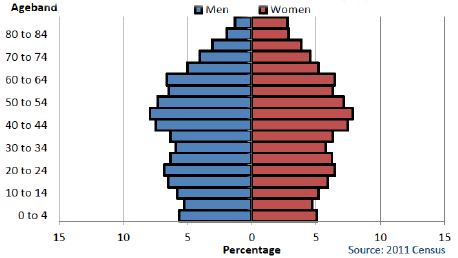
Population Pyramid: Minority Ethnic People, Scotland, 2011
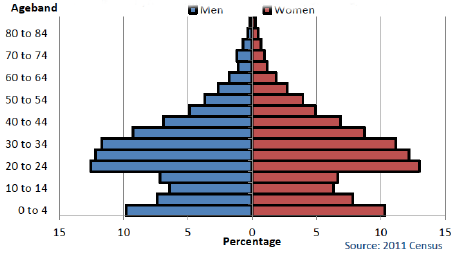
Families with three or more children are another of the priority groups in Every Child Every Chance, and there is evidence that certain minority ethnic groups are more likely than the White-Scottish group to have three or more children.
Number of dependent children by ethnicity of household reference person, 2011
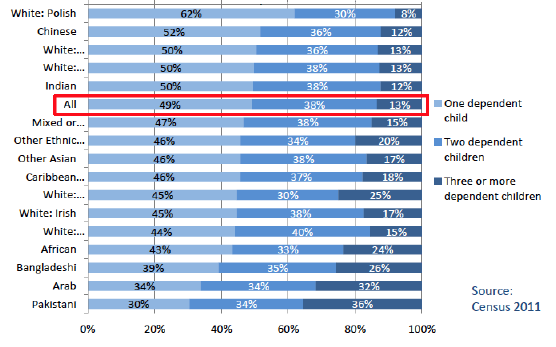
Poverty and ethnicity in Scotland
Children in minority ethnic (non-white) households are more likely to be in poverty than other children in Scotland.
Percentage of children in relative poverty after housing costs (Source: Family Resources Survey)
| 2015/16-2017/18 (3 year average) | |
|---|---|
| All children | 24% |
| White | 23% |
| Minority ethnic | 40% |
| 2013/14-2017/18 (5 year average) | |
|---|---|
| All children | 23% |
| White – British | 22% |
| White – other | 25% |
| Asian or Asian British | 34% |
| Other | 44% |
The poverty gap between children in minority ethnic households and all children has decreased over time, although there are early indications that it may be increasing again.
Percentage of children from each group in relative poverty after housing costs (Source: Family Resources Survey)
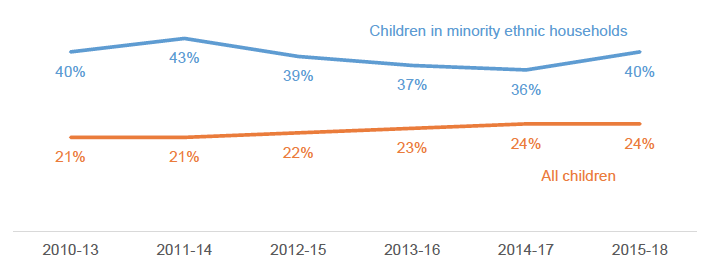
Percentage of children from each group in absolute poverty after housing costs (Source: Family Resources Survey)
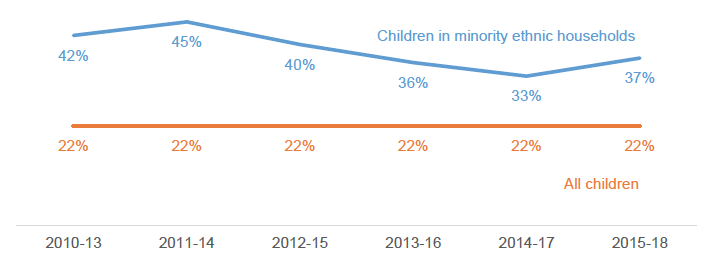
Percentage of children from each group in combined material deprivation and low income after housing costs (Source: Family Resources Survey)

There are, of course, differences in the prevalence and experiences of poverty between (and within) different minority ethnic groups.
Percentage of working age adults from each group in relative poverty (below 60% of UK median income) after housing costs (Source: Family Resources Survey)
2007-17 (10 year average)
| White - British | 17% |
|---|---|
| White - other | 25% |
| Mixed / Multiple ethnic groups | 27% |
| Asian - Indian | 22% |
| Asian - Pakistani | 45% |
| Asian - Other | 42% |
| Asian - Chinese | 51% |
| Black/ African/ Caribbean/ Black British | 39% |
| Other ethnic group | 30% |
Data on the drivers of poverty broken down by ethnicity
Understanding what is driving the higher risk of child poverty among minority ethnic families is hampered by challenges with data availability relating to small sample sizes for minority ethnic groups. The table on pages 13-18 notes what breakdowns of the Child Poverty Monitoring Framework Indicators are available for Scottish minority ethnic households. Where available, these figures are provided and discussed in this paper. Where sample sizes do not allow such a breakdown, alternative indicators have been considered. In most cases (the exception being the data on Scottish school leavers qualifications), individual minority ethnic groups have sample sizes that are too small to reliably report on their own. Therefore, although it is far from ideal, they have been combined into a single 'minority ethnic' category.
Income From Employment
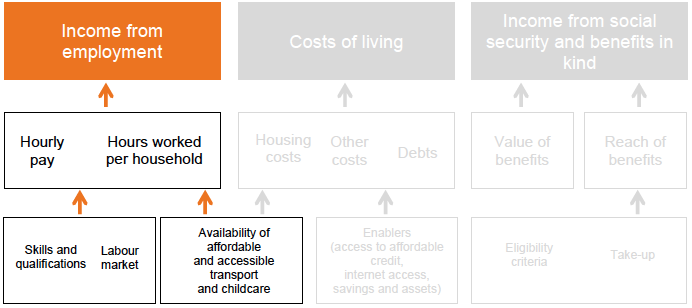
Hours worked
A higher percentage of minority ethnic children live in households where no adult is in paid employment – 16.4%, compared to 11.7% of all children in Scotland (2017 data).[2]
The employment rate for the minority ethnic population aged 16-64 is lower than for the rest of the population – 60.6%, compared to 75.0% for the white population, a gap of 14.4 percentage points (2017 data). The minority ethnic employment gap is much higher for women than men: 22.8 percentage points for women, and 5.7 percentage points for men.
The gap in the employment rate for the minority ethnic population is largest for the 16-24 year old population. The gap decreases with age, with the oldest age group (50-64 years) having higher employment rates for the minority ethnic group than in the white ethnic group. UK level data shows that young people from minority ethnic groups are also more likely to be unemployed (19 per cent compared to 11 per cent for all 16-24 year olds in 2017 at UK level).[3]
Evidence from the 2011 Census shows that employment rates are lower for certain minority ethnic groups, particularly African or Caribbean or Black people.
Economic activity by ethnicity, 2011
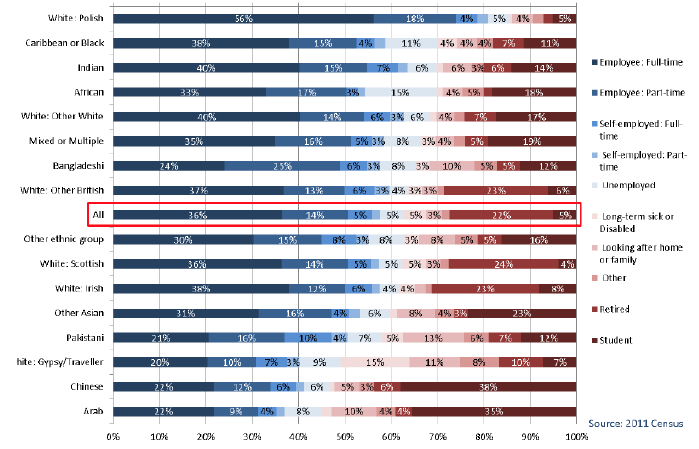
For those families in work, minority ethnic families with children work fewer hours, on average – 24 hours per week per working age adult, compared to 31 hours for all households with children in Scotland (2015-2018 data).
Hourly pay
Minority ethnic households with children also have a lower rate of hourly pay, on average – £10.06 per hour, compared to £12.15 per hour for all households with children in Scotland (2015-2018 data).
UK-level data show that the ethnicity pay gap exists for most minority ethnic groups, with Black African, Caribbean, Pakistani and Bangladeshi men experiencing the greatest disadvantages in the UK labour market. These groups tend to have higher than average representation in routine or semi-routine occupations. The same research found that across all ethnic groups, pay gaps are generally larger for first generation migrants than for UK-born generations.[4]
UK research has shown that the ethnicity pay gap is the result of segregation into less well paid occupations, being in part-time work (which is associated with lower hourly pay than full-time work), and minority ethnic groups being paid less for the same work.[5] Greater unexplained differences in wage levels at the top end of the labour market might be explained by employer discrimination.[6] A number of research reports have also highlighted issues with discrimination and bias in relation to progression and promotion, which will also impact on pay levels across all levels of the labour market.[7]
Labour market
The under-employment rate refers to those who are in work but would like to work more hours for the same rate of pay, a measure of the under-utilisation of labour. The underemployment rate amongst minority ethnic parents is 9%, compared to 7% for all parents (2014-2017 data).
As well as wanting to work more hours, there is evidence that highly qualified minority ethnic parents are not employed in jobs commensurate with their skills and qualifications. Nearly 28% of minority ethnic graduate parents are working in low and medium skilled occupations, compared to nearly 17% of all graduate parents. This echoes other research.[8] UK data on graduate destinations shows that, five years after graduation, only Asian Indian and Asian Bangladeshi men and women surpass the sustained employment rates of white graduates, whereas Black African and Chinese graduates have notably lower employment rates[9].
Skills and qualifications
16.4% of minority ethnic parents in Scotland have low or no qualifications[10], compared to 7.7% of all parents in Scotland. This 2017 APS data shows a larger gap than for non-parents (both groups being around 13%) and appears to contradict the results of the 2011 Census, which found that minority ethnic adults had a higher qualification rate than the general population. This is an area that requires further investigation and research.
In terms of school leaver attainment at SCQF level 5, all minority ethnic groups perform better on average than their white peers, a difference that has persisted over time.[11] The same gap is also evident at SCQF level 6 or better. This contrasts starkly with labour market outcomes for young minority ethnic people.
Percentage of school leavers attaining one or more pass at SCQF Level 5 or better by ethnicity
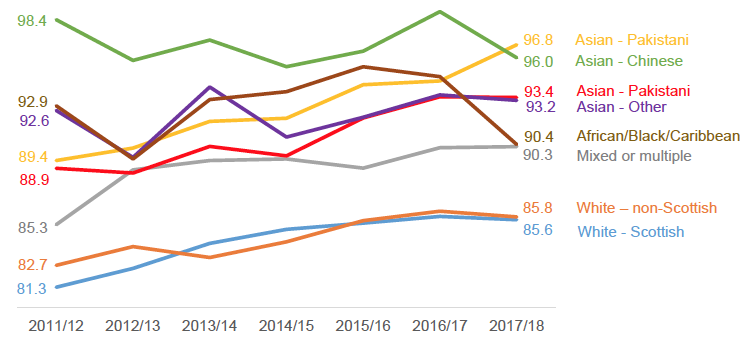
Childcare and transport
There is currently no breakdown of data on the availability and affordability of accessible childcare for minority ethnic groups. However, some data on the affordability of childcare will be available from the Scottish Household Survey in 2021 (once three years of pooled data is available).
Evidence from other sources, including the Joseph Rowntree Foundation (JRF), suggests that some minority ethnic groups are more likely to work irregular, night or weekend hours (e.g. in restaurants or hotels or as taxi drivers), and therefore require more flexible childcare than is currently available.[12]
Another JRF report found that lack of knowledge and information about childcare or support for carers is an important factor in low take-up among some minority ethnic groups, and there is also a lack of inclusive services (both childcare and other care services) that take into account cultural and religious differences[13]. A more recent report by Close the Gap (2019) echoed and added to these findings, and suggested that the lack of cultural sensitivities in formal childcare may be putting some families off from using this type of childcare. For migrant minority ethnic women, the lack of alternative informal networks to help with childcare limited their ability to enter the workforce or increase their working hours. It was also noted that the early years workforce in Scotland is predominantly white, which does not help address perceptions of cultural insensitivities.
On the availability of affordable and accessible public transport, the available data shows that 75.6% of minority ethnic households with children are very or fairly satisfied with public transport, compared to 64.3% of all households with children.
Costs of Living
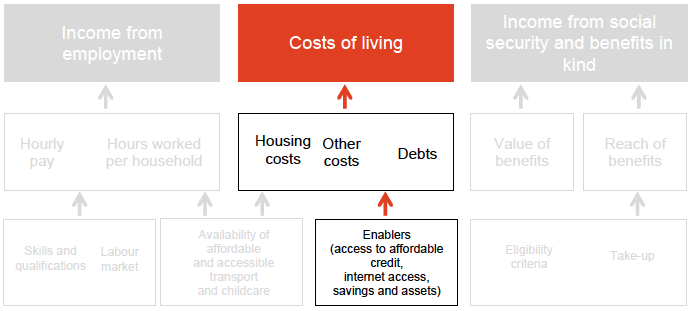
Housing costs
Minority ethnic households with children spent 17% of their net household income on housing costs in 2015-18, compared to 11% for all households with children.
Housing costs have a similar impact on poverty risk for children in minority ethnic households as they do for all children.
Percentage of children in poverty before and after housing costs 2015-18 (Source: Family Resources Survey)
| Relative | Absolute | Material deprivation | ||||
|---|---|---|---|---|---|---|
| BHC | AHC | BHC | AHC | BHC | AHC | |
| Children in ethnic minority households | 35% | 40% | 30% | 37% | 18% | 18% |
| All children | 20% | 24% | 17% | 22% | 11% | 12% |
Other costs of living
There's no data on energy affordability for minority ethnic households with children (whether low income or not), at either Scotland or UK level. However, data for English households shows that 17% of minority ethnic households are living in fuel poverty, compared with 11% of all English households.
Low income minority ethnic households with children in the UK spent 15.2% of their household income on food and non-alcoholic drinks in 2014-2016/17, compared to 16.7% for all low income households with children.
Debt
In 2014-2017, 13% of UK minority ethnic households with children were in unmanageable debt, compared to 9% for all households with children.
Enablers
In 2014-17, 36% of minority ethnic households with children had no savings, which is the same as the percentage for all households with children. Internet access was also similar: 97% of minority ethnic households with children had home internet access, compared to 98% of all households with children.
Income From Social Security And Benefits In-Kind
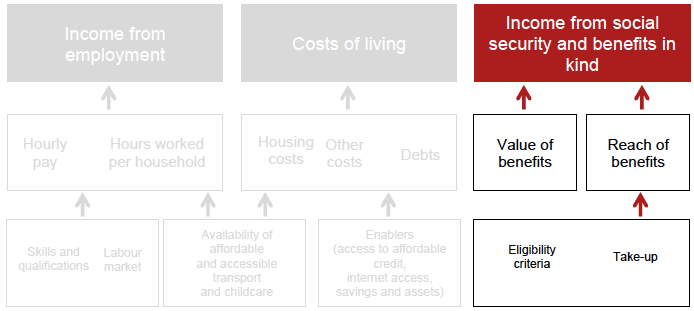
Whilst wages and salaries are a high proportion of many minority ethnic households income (UK data) - higher than white households – many minority ethnic groups have a higher reliance on benefit income than white households.[14] Only Asian Indian and Chinese households have a lower reliance on benefits than white households. Asian Pakistani and Bangladeshi families have the highest reliance on benefit income of all ethnic groups, with the lowest proportion of household income from wages and salaries than any ethnic group.[15]
On take-up of benefits, a quick search and review of evidence suggests that this might be lower amongst minority ethnic groups – with cultural and religious factors leading to non-claiming, under-claiming and delayed claiming, particularly amongst Chinese and Bangladeshi households.[16] However, there does seem to be a lack of evidence in this important area.
Policy and Research Implications
Many of the research reports referenced above have made wide-ranging recommendations for government, and employers, on how to address the issues that minority ethnic families in child poverty face. Most of the recommendations focus on the income from employment driver of child poverty, i.e. the labour market and tackling the underemployment and lower average hourly pay of minority ethnic groups.
Common recommendations to improve the labour market and employment prospects of minority ethnic people include:
- Improving equality monitoring and reporting of recruitment, pay and promotion so that employers can better understand and take action to deal with the issues within their organisations. Strong senior level leadership at CEO and board level is also required to change workplace cultures.
- Removing personal details from recruitment and promotion applications and introducing and communicating clear criteria on what is required for promotion.
- Introducing policies on flexible and part-time working at all levels of different organisations.
- Providing unconscious bias training, and consulting with minority ethnic employees to gauge their perceptions on workplace culture and complaint-handling with a view to ensuring a robust, transparent and supportive complaint-handling procedure.
- Making a stronger link between skills policy and anti-poverty policies so that issues like the affordability of further and higher education for low paid workers are addressed, and so that employers are encouraged to identify and support the acquisition of qualifications that are important for development and promotion.
Other policy suggestions worth highlighting include the use of SG and local authority procurement procedures to promote recruitment and progression for minority ethnic people, and the SG making investment conditional upon employers taking such action where people from ethnic minority communities are underrepresented. One report also suggested that employees should consider 'positive action' schemes where there is persistent underrepresentation.
One of the most striking findings on skills and qualifications is the higher achievement of all minority ethnic school leavers - a trend that has been evident for nearly a decade. Yet, there is a higher rate of unemployment amongst minority ethnic groups, including young people, and a clustering of people of all ages, including young people, employed in certain, often low paid, sectors. It is recommended that research is undertaken to find out what happens to minority ethnic school leavers in Scotland, and why. This could include the LEO database, which tracks minority ethnic graduates outcomes using linked administrative data, but should be broader than this. There is also a need to clarify how the rate of low or no qualifications among minority ethnic adults and parents compares to the general population.
Issues around the accessibility and attractiveness of childcare for minority ethnic groups is an issue raised consistently across different research reports. Two common recommendations to better the accessibility of formal childcare are to:
- Tailor and improve the information about the range of childcare options available, including flexible options from non-mainstream sources, and how formal childcare is being encouraged to be culturally sensitive;
- Improve the ethnic diversity of the childcare workforce. This would help address the cultural and religious barriers to accessing this type of formal childcare. Up to eleven thousand new early years staff are required by 2020 to deliver the expansion of Early Learning and Childcare (the 1140 hours commitment), so this represents an opportunity to address this issue.[17]
Take-up of social security benefits by minority ethnic families may well be an issue, but there is a lack of research in this area. The Social Security Experience Panels programme of research includes qualitative research with ethnic minorities to explore in detail how they want the Scottish social security system to work for them. It is recommended that research should be undertaken in association with the Social Security Experience Panels to examine the issues, and how uptake of devolved and non-devolved benefits can be maximised. However, as panel members are self-selecting, there may be a need to make additional efforts to reach under-represented minority ethnic group families.
Ethnicity breakdowns of Child Poverty Measurement Framework indicators
| Driver | CPMF Indicator | Can CPMF Indicator Be Broken Down by Ethnicity? | Adapted Indicator for Ethnicity Breakdown | Data for Ethnicity Breakdown |
|---|---|---|---|---|
| Hours worked per household | Percentage of children living in households where no adult is in paid employment (Source: Annual Population Survey) | Yes | Not applicable | A higher percentage of minority ethnic children live in workless households - 16.4% compared to 11.7% of all children in Scotland (2017 data), a gap of 4.7 percentage points (Source: Annual Population Survey) |
| Average (median) number of hours worked per working-age adult in working low income households with children (Source: Family Resources Survey) | No – sample size is too small | Average (median) number of hours worked per working-age adult in working households with children | Working-age adults in working minority ethnic households with children work an average (median) of 24 hours per week, compared to 32 hours per week for all households with children (Source: Family Resources Survey, 2015-2018 data). | |
| Hourly pay | Average hourly pay in low income households with children (Source: Family Resources Survey) | No – sample size is too small | Average hourly pay in households with children | Minority ethnic households with children earn an average of £10.06 per hour, compared to £12.15 per hour for all households with children (Source: Family Resources Survey, 2015-2018 data). |
| Labour market | Percentage of parents who are underemployed – defined as unemployed, economically inactive but wanting work, or working part-time because they could not find full-time work (Source: Annual Population Survey) | Yes (by pooling data across years) | Not applicable | The average underemployment rate amongst minority ethnic parents was 9.8%, compared to 7% for all parents (Source: Annual Population Survey, 2014-2017 data). |
| Skills under-utilisation – Percentage of employed graduates aged 16-64 who are in low and medium low skilled occupations (Source: Annual Population Survey) | Yes | Not applicable | 27.8% of minority ethnic graduate parents who are working are in low and medium skilled occupations, compared to 16.7% of all graduate parents, a gap of 11.1 percentage points (Source: Annual Population Survey – 2017 data) | |
| Skills and qualifications | Percentage of parents with no or low qualifications (Source: Annual Population Survey) | Yes | Not applicable | 16.4% of minority ethnic parents have low or no qualifications, compared to 7.7% of all parents (Source: Annual Population Survey, 2017 data) |
| SIMD5-SIMD1 gap in percentage of school leavers who have achieved SCQF Level 5 or better (Source: SG attainment statistics) | Not applicable | Not applicable | Not applicable | |
| Availability of affordable and accessible transport and childcare | Percentage of children's daycare places that are in settings that operate during the school holidays (Source: Care Inspectorate Data) | Not applicable | Not applicable | Not applicable |
| Percentage of children's daycare places that are in settings that are open before, during and after school hours (Source: Care Inspectorate Data) | Not applicable | Not applicable | Not applicable | |
| Percentage of parents paying for any pre-school childcare who report that they find it difficult or very difficult to afford their household's childcare costs (Source: Scottish Household Survey) | Yes (by pooling data across years) | Not applicable | 3 years of pooled data will be available in September 2021 (Source: Scottish Household Survey) | |
| Percentage of low income households with children that are very or fairly satisfied with the quality of public transport (Source: Scottish Household Survey) | No – sample size is too small | Percentage of households with children that are very or fairly satisfied with the quality of public transport | 75.6% of minority ethnic households with children in Scotland are very or fairly satisfied with public transport, compared to 64.3% of all households with children (Source: Scottish Household Survey, 2014-2017 data). | |
| Housing costs | Housing costs as a proportion of net household income for low income households with children (Source: Family Resources Survey) | No – sample size is too small | Housing costs as a proportion of net household income for households with children | Minority ethnic households with children spend 17% of their net household income on housing costs, compared to 11% for all households with children (Source: Family Resources Survey, 2015-2018 data) |
| Other costs of living | Median ratio of required fuel costs to net household income after housing costs for low income households with children (Source: Scottish House Condition Survey modelled fuel bills) | No- sample size is too small | Percentage of households living in fuel poverty – England | 17% of minority ethnic households in England were living in fuel poverty, compared with 11% of all households (Source: ONS Fuel Poverty Statistics, via Cabinet Office ethnicity facts and figures website) |
| Percentage of income spent on food and non-alcoholic drinks by low income households with children (Source: Living Costs and Food Survey) | No – sample size is too small | Percentage of income spent on food and non-alcoholic drinks by low income households with children – UK level | Low income minority ethnic households with children in the UK spent 15.2% of their household income on food and non-alcoholic drinks in 2014-2016/17, compared to 16.7% for all low income households with children (Source: Living Costs and Food Survey) | |
| Debt | Percentage of households with children that are in unmanageable debt (Source: Wealth and Assets Survey) | No – sample size is too small | Percentage of households with children that are in unmanageable debt – UK level | 13% of minority ethnic households with children in the UK are in unmanageable debt, compared to 9% for all households with children (2014-2017 data) (Source: Wealth and Assets Survey) |
| Enablers | Access to affordable credit – use of high cost credit in the past 12 months (Source: Scottish Household Survey) | No – sample size is too small | None | None |
| Percentage of low income households with children that have no savings (Source: Scottish Household Survey) | No – sample size is too small | Percentage of households with children that have no savings | 36% of minority ethnic households with children have no savings, compared to 36% of all households with children (Source: Scottish Household Survey, 2014-2017 data) | |
| Percentage of low income households with children that have home internet access (Source: Scottish Household Survey) | No – sample size is too small | Percentage of households with children that have home internet access | 97% of minority ethnic households with children have home internet access, compared to 98% of all households with children (Source: Scottish Household Survey) | |
| Reach of benefits | Share of total income from social security going to households with children that goes to low income households (Source: Family Resources Survey) | Not applicable | Not applicable | Not applicable |
| Generosity of benefits | Real terms value (£/pw) of reserved social security entitlement (JSA+CTC+Child Benefit) for out-of-work couple households with two children (Source: DWP benefit rates) | Not applicable | Not applicable | Not applicable |
| Real terms value (£/pw) of reserved social security entitlement (WTC+CTC) for a lone parent working full-time / couple with one working full-time and one not in paid employment, on minimum wage, with two children (Source: DWP benefit rates) | Not applicable | Not applicable | Not applicable | |
| Real terms value (£) of school clothing grant – average value across Scottish local authorities, with weighting to adjust for the different numbers of school pupils in each local authority (Source: Scottish Government survey of local authorities) | Not applicable | Not applicable | Not applicable | |
| Take-up | Percentage of children registered for Free School Meals (including all Primary 1 to Primary 3 pupils registered under the universal provision) who took a free school meal on the day of the survey (Source: Healthy Living Survey) | No – ethnicity data not collected | None | None |
Contact
Email: DLECJBCADESJA@gov.scot
There is a problem
Thanks for your feedback